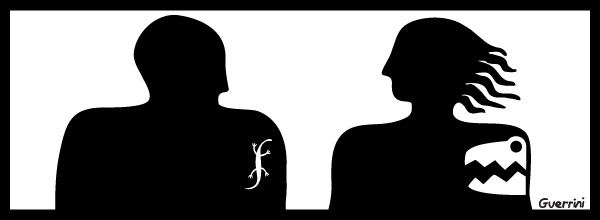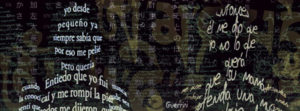Just as the Greek goddess Medusa turned all who gazed upon her into stone, the symbols of today also posses this power to transform all who look upon them.
Almost magically, symbols appear when least expected: painted upon the tiles of a public plaza or tattooed in the most intimate of places—symbols appear in our lives out of nowhere and without cause.
Because of this mythic quality, and beyond all intensions, symbols have power:
In one regard, symbols have the power to deceive, tricking us into believing that which they represent is actually present or real.
They trick us when we believe that whoever wears the symbol embodies that image, that is to say, we believe that the symbol and the person are one in the same.
They trick us when the images present in the symbol transport us to faraway cultures, to special moments or sensations that wouldn’t normally correspond to our lives. What’s more, they trick us when the symbol represented moves us emotionally, bringing us hope or happiness; meanwhile, that which or who displays the symbol is indifferent to the effects the symbol has upon us.
Furthermore, we are tricked when these images make us think about something that never crossed our minds previously, but due to their influence, now enters our present thoughts.
In conclusion, we are tricked by symbols when we believe in them.
Beyond the deception, symbols posses yet another power: they give form to that which has none, making concrete what was once just sensations, ideals, intuitions, beliefs and values. For example: What would the Republic be without the face of youth to represent it, the Olympics without its rings, the Catholic Church without its cross or the Hippie movement without its peace symbol?
Likewise, symbols have the power to help define that which is and is not, from the moment they enter the world, comparisons are instantaneously born. Why we see a specific symbol as big or small, rudimentary or elegant, mystical or earthly has everything to do with its relation to other symbols, other contexts and other emotions.
That said, are symbols bad? Perhaps, or maybe it’s just that our life experiences can only be expressed through symbols, and thus, through these symbols alone can the meaning of life be sought and defined.
© Sebastian Guerrini, 2010









Congratulations for this insightful article, Sebastián, and for all your thoughts and work on branding!
Juan Carlos
Gracias Juan Carlos! Sebastian
Sebastian,
Muy bueno lo Suyo.
La verdad que es muy interesante lo que propone.
Debemos ver la posibilidad de aplicacion a la empresa que represento.
Gracias.
Christian
Gracias Christian, un abrazo. Sebastian
Sebastián,
Muy bueno que compartas con nosotros tus pensamientos.
Estoy empezanco un proyecto personal en comunicación y lo que escribis esta buenisimo para ponernos a pensar.
Placer leerlos.
Saludos,
Hernán.
Gracias Hernán, un abrazo
Sebastian, I really like your text. I specially highlighted this: “(Symbols) give form to that which has none”.
With love,
Marcelo